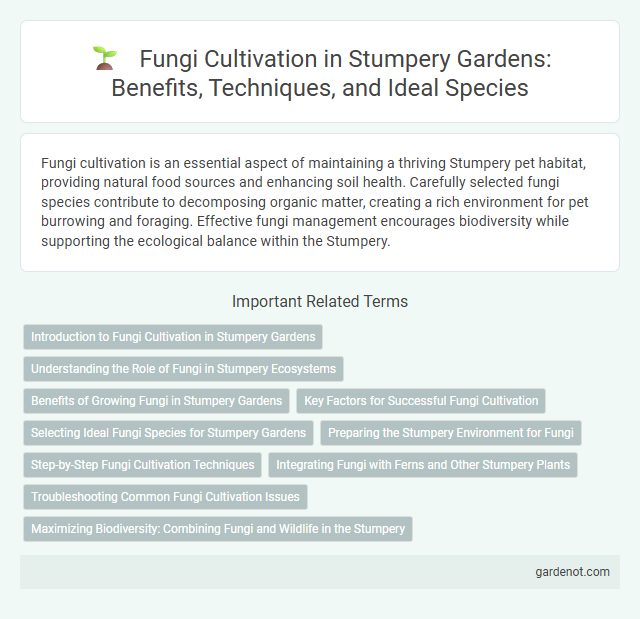Fungi cultivation is an essential aspect of maintaining a thriving Stumpery pet habitat, providing natural food sources and enhancing soil health. Carefully selected fungi species contribute to decomposing organic matter, creating a rich environment for pet burrowing and foraging. Effective fungi management encourages biodiversity while supporting the ecological balance within the Stumpery.
Introduction to Fungi Cultivation in Stumpery Gardens
Fungi cultivation in stumpery gardens involves nurturing diverse mushroom species on decaying wood and damp substrates, creating a rich ecological niche. This practice enhances biodiversity by promoting fungal networks crucial for nutrient cycling and soil health. Selecting native fungi species adapted to local climates ensures successful colonization and sustainable growth within the stumpery ecosystem.
Understanding the Role of Fungi in Stumpery Ecosystems
Fungi play a crucial role in stumpery ecosystems by decomposing dead wood and facilitating nutrient cycling, which supports plant growth and biodiversity. Mycorrhizal fungi form symbiotic relationships with tree roots, enhancing water and nutrient absorption while improving soil structure. Understanding these ecological functions enables effective cultivation of fungi, promoting healthier and more resilient stumpery environments.
Benefits of Growing Fungi in Stumpery Gardens
Stumpery gardens provide an ideal environment for fungi cultivation by offering decaying wood and shaded moisture, which promote robust mycelium growth essential for nutrient cycling. Growing fungi in stumperies enhances soil fertility by breaking down organic matter and releasing vital minerals, supporting surrounding plant health and biodiversity. Fungi also contribute to pest suppression and disease resistance, making stumpery gardens a sustainable ecosystem for horticultural and ecological balance.
Key Factors for Successful Fungi Cultivation
Key factors for successful fungi cultivation include maintaining optimal humidity levels between 85-95% and temperatures ranging from 55degF to 75degF, which vary depending on the fungal species. A sterile substrate rich in organic material, such as decaying wood or leaf litter, provides essential nutrients and promotes mycelium growth. Proper ventilation and indirect light prevent contamination and support healthy mushroom development in stumpery settings.
Selecting Ideal Fungi Species for Stumpery Gardens
Choosing ideal fungi species for stumpery gardens involves prioritizing native and shade-tolerant varieties such as oyster mushrooms (Pleurotus ostreatus) and turkey tail (Trametes versicolor) that thrive on decaying wood. Selecting species that decompose hardwood stumps efficiently enhances nutrient cycling and supports a healthy micro-ecosystem. Incorporating diverse fungal species promotes biodiversity and resilience within the stumpery environment.
Preparing the Stumpery Environment for Fungi
Creating an ideal stumpery environment for fungi cultivation involves selecting well-decayed logs and shaded, moist areas to mimic natural forest conditions. Maintaining high humidity and ensuring adequate airflow prevents fungal spores from drying out while reducing the risk of mold infestation. Incorporating diverse organic matter such as leaf litter and wood chips enriches the substrate, promoting robust fungal growth and biodiversity.
Step-by-Step Fungi Cultivation Techniques
Step-by-step fungi cultivation begins with selecting a suitable substrate, such as decaying wood or leaf litter, ideal for spore germination. Inoculate the prepared substrate with high-quality mycelium spawn, maintaining optimal moisture levels between 60-70% and a temperature range of 20-24degC for robust mycelial growth. Regularly monitor humidity and airflow in the cultivation environment to prevent contamination and promote healthy fruiting body development in the stumpery setup.
Integrating Fungi with Ferns and Other Stumpery Plants
Cultivating fungi within a stumpery creates a symbiotic environment that enhances the growth of ferns and other shade-loving plants by improving soil nutrient cycling. Mycorrhizal fungi form mutualistic associations with fern roots, increasing water absorption and resistance to pathogens in stumpery gardens. Incorporating diverse fungal species such as oyster mushrooms (Pleurotus ostreatus) alongside ferns optimizes decomposition of woody debris, enriching the humus layer critical for a thriving stumpery ecosystem.
Troubleshooting Common Fungi Cultivation Issues
Fungi cultivation in stumperies often faces challenges such as contamination by competing molds, which can be mitigated by maintaining sterile conditions and using high-quality spawn. Insufficient humidity levels slow mycelium growth, making it essential to monitor and regulate moisture through misting or humidity domes. Nutrient depletion or unsuitable substrates can cause poor yield, requiring substrate optimization with materials like wood chips, bark, or leaf litter rich in organic matter.
Maximizing Biodiversity: Combining Fungi and Wildlife in the Stumpery
Integrating diverse fungi species within the stumpery enhances soil health and attracts a variety of wildlife, promoting a robust ecosystem. Cultivating mycorrhizal fungi alongside saprophytic varieties supports nutrient cycling and plant growth, creating habitats for insects, amphibians, and small mammals. This synergy between fungi and fauna maximizes biodiversity, making the stumpery a vital refuge for ecological balance.
Fungi cultivation Infographic

 gardenot.com
gardenot.com